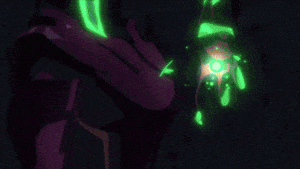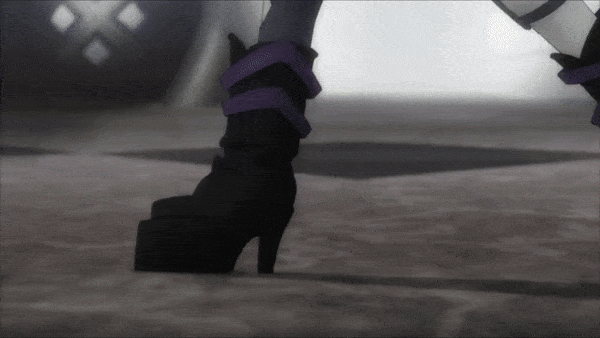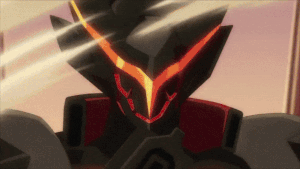
|
|
Metallic Rouge
 The moment has arrived for fighting. There is no escape or hiding. If you've read any number of my Reviews on this site so far, you'll know beyond a shadow of a doubt that I love a good science fiction story, especially in animated form. Illustration and animation are vital elements of the genre, bringing the most imaginative and flashy sequences to life by virtue of making the impossible possible. Animation is also the ideal tool for making action larger than life, and for exaggerating the small moments that give characters their charm and presence. And for these reasons, Metallic Rouge is a great example of why sci-fi works best in animation.
 It would not be IMPOSSIBLE to shoot something like this in live-action, but let's be honest, it wouldn't look anywhere near as cool. Now, anime is always positioned in an awkward spot. The vast majority of what gets produced is sourced from manga, visual novels, and video games, with very few (by comparison) completely original series. By this metric, most folks will almost always default to the common opinion that "the manga was better", because that's where most anime stories originate, coming directly from the hand of the person who created it. There's probably also a good bit of bias from people who just prefer to read a story rather than watch it. But this is also a big reason a lot of original anime series don't get quite the same coverage or praise that they deserve; they don't come pre-equipped with huge followings from manga readers, and require a bit more investment from viewers who don't have the luxury of already knowing what will happen in the next episode. But - at least in my own experience - original anime with no source material to speak of tend to make far more interesting and compelling animated series than adapted titles. See for example: Flip Flappers, Lycoris Recoil, and of course, the legendary Cowboy Bebop. Metallic Rouge is no exception.
 Animation works best when it's allowed to be ITSELF, without the need to follow or conform to a previous incarnation it's being adapted from. The story takes place in a world where planets of the known solar system are slowly being terraformed and colonized (with the help of some technology acquired from two distant warring alien races), and humans now live alongside a new race of androids they've created called "Neans". Though they speak and function convincingly like humans, most of them bear distinctive mechanical markings and carry a certain innocent naïveté about them that make them easy to identify. And of course, as a created "race" of beings living on planets ruled by humans, Neans are treated as second-class citizens or even slaves by an indifferent and often cruel society.
 Don't worry, that bitch got exactly what it deserved. The key to all this is the famous Asimov Code, a staple of science fiction created by real-world author Isaac Asimov in many of his stories (most famously, from his collected works in "I, Robot"). Put simply, this law indicates that - discriminately - a robot cannot harm a human, must obey a human, and must protect itself from danger. This law ensures that robots, androids, and various automatons can only perform their intended function, and can't resist or fight back against a human, or be used by a human to harm another human. The law says nothing, however, about a robot harming another robot. This lack of agency and inability to disobey or rise up in revolution maintains that all robots remain the ideal slave workers or cannon fodder. Neans in this world are hard-bound by that code, and to that end, many hold "jobs" as traveling companions, butlers, or physical laborers for terraforming projects on harsh and volatile planets such as Venus. Even crueler, humans literally hold the keys to their very life force: a golden "nectar" of sorts that Neans are powered by. If any Nean "steps out of line" - or if people just feel like being assholes - they can lord this over them, threatening their very life (if you can call it a life) by withholding nectar from them. And because Neans are programmed with the Asimov Code, they can do nothing about it but live a life of subservience and hope they get stuck with "one of the good humans".
 Humans withholding vital medical injections for a portion of the population they see as lesser or inferior? Nah, there wouldn't be any real-world parallels to draw here, would there? But enough about shitty humans, let's talk about our ACTUAL cast of characters! Enter Rouge Redstar and her partner Naomi Orthmann. Rouge is a powerful Nean with the ability to "de-form" into a battle suit, and is entirely programmed WITHOUT Asimov's Law. She and Naomi are tasked by the Alethia company (responsible for all production and oversight of Neans) with hunting down and assassinating a group of Nine other similarly "unbound" Neans. This group - The Immortal Nine - stand accused of the murder and abetment of a certain high profile scientist, and must be brought to justice before they do any further violation of the Asimov code. Naomi provides the special clearance and handles logistics, while Rouge provides the muscle, and the series follows them as they track down the Immortal Nine and unravel a series of difficult truths in the process.
 Genderfluid piano players everywhere can relate, I'm sure. I really love this series' approach to story-telling. As with all great animated sci-fi, it's told in a dramatic and often flashy way that takes full advantage of its stunning visual identity, but the actual story beats and character interactions remain very grounded and down-to-earth. Rouge is built like a young adult, but is chronologically only about ten years old, and exhibits a distinct childlike lack of judgment and grasp of social cues, much to "sarcastic older sister" Naomi's chagrin. Reading a bit like someone on the spectrum, Rouge isn't hyperactive or immature per se, just a bit too literal and easily misinformed or mislead. The relationship between her and Naomi as they travel together tracking down their targets is a major driving force of the series' charm.
 As a reminder, this is an action thriller driven by speculative fiction and mecha suit fights. But that doesn't mean it's above sprinkling in a little comedy here and there. Likewise, Naomi is easily my favorite character. Charismatic and oh-so-stylish, she uses her mysterious elevated status and restricted access to pull strings behind the scenes, delivering messages to Rouge through a tiny bird-shaped robot that lands on her shoulder. She can hold her own in a fight, but prefers to let Rouge do the heavy lifting while she plays the tactician instead. Her witty sarcasm, quick thinking, and flamboyant love of food are just a delight to watch, especially in the dynamite English dub. Cassie Ewulu's performance combined with the show's expressive animation really takes Naomi's character from a solid 9 to a perfect 10 for me.
 Just look at her. Love this girl right here. Speaking of dubs, no disrespect to the Japanese voice cast here, but like Cowboy Bebop before it, this is definitely a show best watched in English. Most anime that takes place in Japan or is written from a Japanese perspective makes sense to watch in Japanese, but Metallic Rouge bears a very distinct multicultural flavor, which should be immediately evident from the fact that there are more than two skin tones present in the series. I'm just saying, it would be a shame to miss out on one of the key features that makes this show stand out if you're generally dub-squeamish!
 Impossible and stylish action is anime's calling card, but there's something equally satisfying about seeing a well-animated realistic fight scene as well. Anyway, the real meat and potatoes of the series can be found in the way it discusses freedom and agency. As Rouge and Naomi work their way down the list taking out targets one by one, they learn that some members of the Immortal Nine aren't even concerned about the alleged murder case, and are in fact working on something much bigger. They're actively untangling a complex plot in which might be found a way to overwrite the Asimov Code in all Neans, to release them from the confines of their programming and free them from eternal servitude. At the behest of another key story player - a mysterious hunchback wearing a drama mask who aptly goes by the name "Puppetmaster" - Rouge and the other members of the Nine must continually confront the question of why they're doing what they're doing, and whether or not they actually possess the capacity to act on their own volition. Rouge in particular is repeatedly pestered with this question, especially since most of the series involves her following Naomi's lead or carrying out her instructions, trusting that she's acting in good faith. Their relationship gets put to the test as more information about Naomi is revealed in bits and pieces, and Rouge must examine not only why she follows Naomi's orders, but if she can even trust Naomi as a friend, much less a partner. And it all hinges on whether or not Rouge and the other Neans are actually free to make their own choices, or if they've been nothing more than a pre-programmed puppet show this entire time.
 Reaper Overwatch who? Now, there's nothing particularly new or inventive about this specific topic in the science fiction community at large, but it's a topic for which more stories and viewpoints are always welcome in my household. In Metallic Rouge's case, I felt the actual plot unfolded in a very natural and interesting way, with minimal effort spent on characters explaining to the audience what's happening, so that we are free to solve the puzzle for ourselves as we go. I've heard others describe the plot or certain key scenes as "rushed", but I can't bring myself to agree. Things just happen in rapid succession - sometimes with little explanation - giving the series a snappy, punchy pace. (I assume this was also likely due to a very tight budget, as executives and production companies aren't usually keen on spending more than they need to on original series with no pre-existing fanbase to back them up). Additionally, at the risk of sounding like a crusty Old Person, I find it pretty fucking hypocritical when people marathon through a series as quickly as possible to avoid spoilers or having to wait a week in between episodes, and then have the audacity to call the series itself rushed. It's one thing to criticize a scene if you feel that it failed to "hit" you emotionally, but it's another thing entirely to act like the entire show is poorly paced when you don't take advantage of the episodic format it's presented in. The point of a series being split into episodes - as opposed to a movie, which is ideally viewed in one sitting - is to allow the viewer to pause between each segment to digest or ruminate on what just transpired. You'll find you complain a lot less about "pacing issues" if you just take advantage of this format!
 Just in case you were worried I would somehow forget to post a gif of a lesbionic nature... Anyway, even though it took me an episode or two to warm up to it, I really enjoyed Metallic Rouge. The intriguing blend of sci-fi action thriller and stylish mecha/superhero aesthetic, cooked in a delicious stew of multicultural influences and wrapped in a layer of eclectic and varied soundtrack choices, definitely scratched that itch for me, though it seems like popular consensus is a bit mixed. Give it a try yourself, see what you think of it! If you enjoyed the show, or want to try something different in a similar flavor, here are my recommendations to follow it up. For more heavily stylized stories about androids overcoming the limits of their programming, Vivy: Fluorite Eye's Song is hands-down my best rec. For more sci-fi anime that don't hold your hand and expect you to keep up, check out Ergo Proxy and Texhnolyze. Or if you just want an action thriller with another definitely-not-in-a-relationship Rouge/Naomi type girl/girl power couple, you can't go wrong with old classics like Dirty Pair and Noir.
 Never underestimate the comedic genius of simply using a literal punch line as a punchline. And on one final note, seeing the incredibly cool character designs for this show has definitely piqued my interest in creator Yutaka Izubuchi's other well-known mecha series "RahXephon". I rarely see this anime mentioned on its own merit (usually only in comparison to other, more successful series like Neon Genesis Evangelion), but it definitely looks like something I'd like to watch sometime! ...y'know, eventually.
|
|